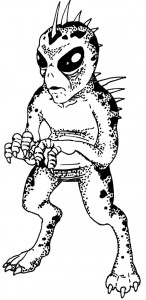
May 21, 2010
Chupacabras Solution: Neither New Species, Nor Silly
by Loren Coleman

Ben Radford, the managing editor of Skeptical Inquirer, appears to have made a major breakthrough regarding Chupacabras, after all. Radford, it can be told, has identified a precise popular foundation to the explosive beginnings for the widespread interest in Chupacabras beginning in 1995.
As is well known to readers of Cryptomundo, Radford is the author of a “detailed and exhaustive”
book on Chupacabras, due in 2011, from the University of New Mexico Press. He has already spoken often of how his revelations will solve the Hispanic mystery of these creatures.
Ben Radford has now jumped his own game of anticipation, and has given away the end of his story. In a just-published new book entitled Scientific Paranormal Investigation: How to Solve Unexplained Mysteries (Corrales, NM: Rhombus, 2010), Radford spills all his Puerto Rican beans.
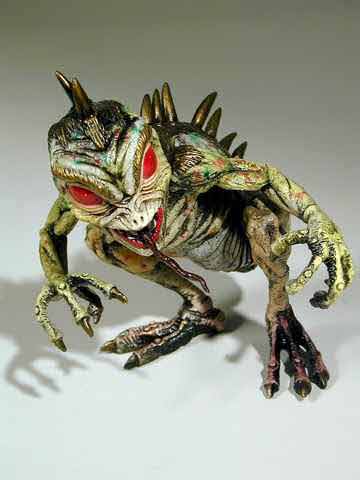
Indeed, Radford writes in this new book that due to his investigation, the “chupacabra mystery crumbled and the solution was complete.”
What does Radford say was behind the outpouring of interest in the Chupacabras? Radford points to a less-than-credible eyewitness who, he says, appears to have mixed a movie’s impact with her sighting descriptions of one of the first widely-reported Chupacabras cases. Radford blames the Chupacabras, as we know it today, on the movie Species’
shape-shifting humanoid creature, Sil.
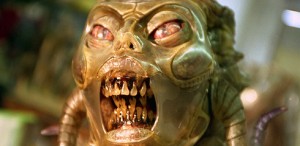
Radford writes (pp. 297-298):
“A young woman named Madelyne Tolentino of Puerto Rico gave the most important chupacabra description on record, not only because of its remarkable detail but also because it is the ‘original’
description upon which almost all images of the creature are based.
“Tolentino claims that she saw the creature near the street from her mother’s house during the second week of August, 1995.”
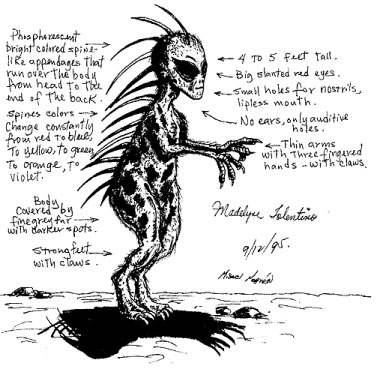
Radford is clearly correct in this regard, and the drawing made based on Tolentino’s sighting, was the one that was used over and over by the media, book illustrators, and investigators.
Radford goes on (p. 298), after doing a little reading on the case, to find that “this ‘eyewitness account’ is riddled with implausible observations, contradictions, and inconsistencies….There was not a shred of evidence to support Tolentino’s incredible story…Yet…her description became the ‘standard’ chupacabra image known worldwide.”
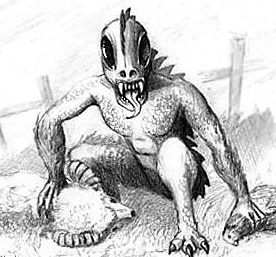
Looking for a missing piece of his puzzle to “solve”
the Chupacabras mystery, Radford found what he was looking for.
“Just before Tolentino’s sighting, a new element was added to the island’s social and cultural mix –
something that had not existed there before and could have spawned chupacabra sightings. The creature Tolentino described bears no resemblance to any known animal. It does, however, look almost exactly like a fictional creature seen by hundreds of thousands of people in 1995: Sil.
“Sil is the name of the alien creature played by Natasha Henstridge in the science-fiction horror film Species. Species was released in Puerto Rico on July 7, 1995 – less than a month before Tolentino reported her chupacabra sighting. The creatures looked very similar; could the original chupacabra eyewitness have simply described a monster she saw in a movie? It’s certainly possible,”
says Radford, (p. 300).
One of the most damning pieces of evidence for Radford was found in investigator Scott Corrales’ 1997 book, Chupacabras and Other Mysteries. In Corrales’ text, it is noted that Tolentino made the connection between Sil and the Chupacabras herself. Tolentino told an interviewer that she had seen a “movie called Species…
.The movie begins here in Puerto Rico, at the Arecibo observatory.”

Tolentino’s comparison between the Chupacabras creature she had seen and the one in the movie is mentioned in Corrales’ book, when she notes the movie monster “was a creature that looked like the chupacabra, with spines on its back and all….The resemblance to the chupacabra was really impressive….I watched the movie and wondered, ‘My God! How can they make a movie like that, when these things are happening in Puerto Rico?”
An interviewer asked Tolentino in Puerto Rico, in 1996, Corrales noted: “In other words, does [Species] make you think there might have been an experiment in which a being escaped and is now at large?”
Tolentino answered: “Yes.”
Radford then writes (p. 302): “Thus it seem [sic] that Tolentino believed that the creature and the events she saw in Species were actually happening in reality in Puerto Rico at the time.” [Emphasis is Radford’
s]
I wonder if Radford’
s chronology is a bit off? But let me return to that in a moment.
He writes, “Remember, Species was seen by the Puerto Rican public at the exact same [sic] time that the chupacabra hysteria occurred. This confusion between fact and fiction, reality and fantasy, says much about her credibility.”
Ben Radford makes no bones about what his conclusion is (p. 302): “The popular image of the chupacabra – the one appearing on thousands of books, magazines, and Web sites as a credible eyewitness description – is in fact based on a science fiction film.”
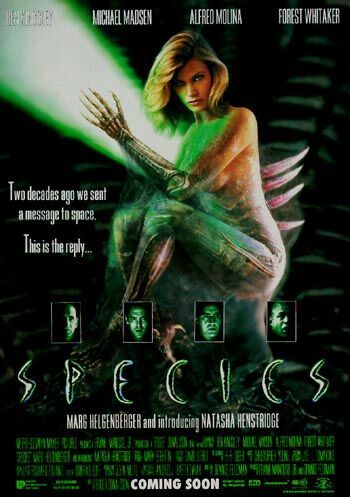
Okay, a few agreements and cautions need to be added to the end here.
Ben Radford’s conclusions before this Sil business that he shares in his Chupacabras summary in his new book are hardly earthshaking. Although he does not clearly state it, he seems to be in agreement with cryptozoologists who have found little of worth in all the findings of dead dogs, recovered mangy coyotes, and photographed less-than-cryptid canids with and without mange that have been labeled “chupacabra”
in recent years.
While Radford acknowledges that livestock killings were discovered in the months before the Tolentino sighting, there is no direct link between them and any reported Chupacabras.
I must congratulate Radford for his discovery and linkages, in images, popular cultural impact, and the copycat effect, between the Tolentino sketches and the appearance of Sil from Species.
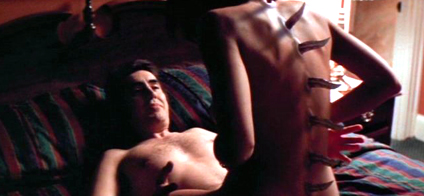
I can only imagine that those viewing Species were distracted by Natasha Henstridge, and missed that her changed form had a striking resemblance to the Chupacabras in the news a few months later. (This is not to be taken as a serious excuse on my part, and is merely a poor attempt at humor. Do excuse me for the momentary respite in this otherwise serious study of a worldwide phenomenon and Ben’s theory.)

I am left with some questions, not to debunk Radford, but merely to understand his revelation a bit more.
Did Tolentino see Species before her sighting (as Radford seems to be implying), or could she have seen the film after her alleged encounter, only then making the comparison from that frame of reference, as the Corrales book seems to be saying?
This is a valid point to explore. I have often interviewed eyewitnesses who are so traumatized by their observations and experiences that part of their psychological process is to find an anchor, a popular cultural framework or familiar image to make their event “feel” more “real.”
This is sometimes done with fictional characters too, as what they saw was so weird and remarkable that even fictional sources are searched to try to point to as similar to what it was they sighted. For example, this happened with the media commentary, after the Dover Demon 1977 case, when references to drawings of the Golem in The Hobbit and The Lord of the Rings were made.
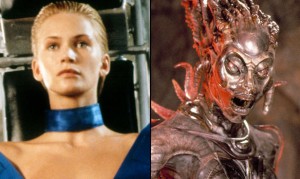
What if Tolentino only saw the movie Species after her sighting, and then made the link, which was only revealed in a 1996 interview, a year later?
I do congratulate Radford for his detective work, but I think he would agree that if his solution is a “fact,”
as he states, it will stand the test of further investigation itself.
There are other historic points I’
ve chronicled in my book, Cryptozoology A to Z and here on Cryptomundo that need addressing.
The real explosion of the Chupacabras phenomenon only took place after there was a segment broadcast on the Spanish Univision program Christina, a popular show not unlike the English-speaking program at the time headed by Oprah Winfrey. That happened in March 1996, long after Species opened in Puerto Rico in July 1995, and the Tolentino sighting in August 1995. How does that figure into Radford’s theory and Tolentino’s statements?
Furthermore, how does Radford explain the longer history of Chupacabras discovered by Corrales and myself, such as the first mention of Chupacabras on television, on “Bonzana”
in 1960, of creatures that sucked milk from goats?
Good for Benjamin Radford, I say, nevertheless. Now let’
s discuss what we think of his findings, not perhaps a final solution but at least a workable theory, as he has presented it.
It is not silly, and we have to now review what Sil’s influence may have been during the dawn of the modern Chupacabras era.
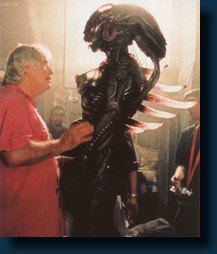
About Loren Coleman
Loren Coleman is one of the world’s leading cryptozoologists, some say “the” leading living cryptozoologist. Certainly, he is acknowledged as the current living American researcher and writer who has most popularized cryptozoology in the late 20th and early 21st centuries.
Starting his fieldwork and investigations in 1960, after traveling and trekking extensively in pursuit of cryptozoological mysteries, Coleman began writing to share his experiences in 1969. An honorary member of Ivan T. Sanderson’s Society for the Investigation of the Unexplained in the 1970s, Coleman has been bestowed with similar honorary memberships of the North Idaho College Cryptozoology Club in 1983, and in subsequent years, that of the British Columbia Scientific Cryptozoology Club, CryptoSafari International, and other international organizations. He was also a Life Member and Benefactor of the International Society of Cryptozoology (now-defunct).
Loren Coleman’s daily blog, as a member of the Cryptomundo Team, served as an ongoing avenue of communication for the ever-growing body of cryptozoo news from 2005 through 2013. He returned as an infrequent contributor beginning Halloween week of 2015.
Coleman is the founder in 2003, and current director of the International Cryptozoology Museum in Portland, Maine.
Filed under Breaking News, Chupacabras, Cinema News, Conspiracies, Cryptomundo Exclusive, CryptoZoo News, Movie Monsters, New Species, Pop Culture, Skeptical Discussions